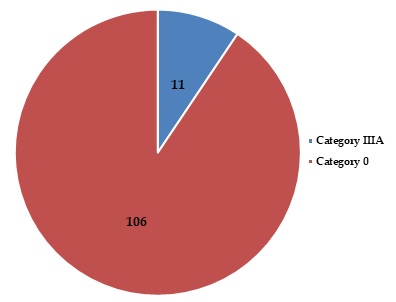Qualitative Evaluation on the Use of Pneumonia Antibiotics for Covid-19 Patients at X Hospital Bali in 2020
Abstract
Coronavirus disease-19 (Covid-19) is a pandemic that has caused various complications, including pneumonia. One of the therapies used in Covid-19 with pneumonia complications is antibiotics. Antibiotics must be used appropriately to prevent antibiotic resistance. A method to reduce the number of antibiotic resistances is evaluating the use of antibiotics qualitatively using the Gyssens method. Therefore, this study aims to describe the profile and rationality of using pneumonia antibiotics for adult Covid-19 patients at X Hospital from January to December 2020. The data was collected retrospectively on adult patients using the patient's medical record data, and the sample was determined using the purposive sampling technique. There were 117 samples of medical record data processed in this study. This study concluded that the use of antibiotics for patients with Covid-19 disease consisted of single antibiotic usage, i.e., azithromycin in 82 cases (70.09%), and levofloxacin in 30 cases (25.64%), and switched antibiotics usage, i.e., azithromycin to levofloxacin in 5 cases (4.27%). The rationality of using antibiotics using the Gyssens methods was 90.60% with rational or appropriate antibiotics use (category 0). Moreover, there was 9.40% irrational drug use (category I-VI), comprising antibiotics for a longer time than it should be, in 11 cases.
Full text article
References
2. Sipahutar T, Eryando T. COVID-19 Case Fatality Rate and Detection Ability in Indonesia. Kesmas Natl Public Health J. 2020;15(Special Issue 1):14-7. doi:10.21109/kesmas.v15i2.3936
3. Grief SN, Loza JK. Guidelines for the Evaluation and Treatment of Pneumonia. Prim Care. 2018;45(3):485-503. doi:10.1016/j.pop.2018.04.001
4. Burhan E, Isbaniah F, Susanto AD, Aditama TY, Sartono TR, Sugiri YJ, et al, editors. Pneumonia Covid-19: Diagnosis dan Penatalaksanaan di Indonesia. Jakarta: Perhimpunan Dokter Paru Indonesia; 2020.
5. Zhou F, Yu T, Du R, Fan G, Liu Y, Liu Z, et al. Clinical course and risk factors for mortality of adult inpatients with COVID-19 in Wuhan, China: a retrospective cohort study. Lancet. 2020;395(10229):1054-62. doi:10.1016/s0140-6736(20)30566-3
6. Gyssens IC. Audit for Monitoring the Quality of Antimicrobial Prescription. In: Gould IM, van der Meer JWM, editors. Antibiotic Policies. Boston (MA): Springer; 2005. doi:10.1007/0-387-22852-7_12
7. Han MK, Martinez FJ. Host, Gender, and Early-Life Factors as Risks for Chronic Obstructive Pulmonary Disease. Clin Chest Med. 2020;41(3):329-37. doi:10.1016/j.ccm.2020.06.009
8. Antao VC, Pinheiro GA. Surveillance for occupational respiratory diseases in developing countries. Semin Respir Crit Care Med. 2015;36(3):449-54. doi:10.1055/s-0035-1549456
9. Roman MA, Rossiter HB, Casaburi R. Exercise, ageing and the lung. Eur Respir J. 2016;48:1471-86. doi:10.1183/13993003.00347-2016
10. Yadegarynia D, Tehrani S, Maghsoudi FN, Shojaeian F, Keyvanfar A. Levofloxacin versus ceftriaxone and azithromycin for treating community-acquired pneumonia: a randomized clinical trial study. Iran J Microbiol. 2022;14(4):458-65. doi:10.18502/ijm.v14i4.10231
11. Perhimpunan Dokter Paru Indonesia. Pneumonia Komuniti: Pedoman Diagnosis dan Penatalaksanaan di Indonesia. Jakarta: Perhimpunan Dokter Paru Indonesia; 2003.
12. Wells BG, DiPiro JT, Schwinghammer TL, DiPiro CV. Pharmacotherapy Handbook: Ninth Edition. New York; McGraw Hill: 2015.
13. Widyati, Harijono P, Tuba S. Analysis of Antibiotic Usage in Critical COVID-19 Patients with Secondary Infections. J Biosci Med. 2022;10(12):122-33. doi:10.4236/jbm.2022.1012011
14. Rusmini H. Gambaran Penggunaan Antibiotik pada Pasien Pneumonia dengan Menggunakan Metode Gyssens di Rawat Inap Rumah Sakit Umum Daerah (Rsud) H. Abdul Moeloek Tahun 2015. J Medika Malahayati. 2016;3(2):61-4. doi:10.33024/jmm.v3i2.2009
Authors
Copyright (c) 2023 Wirda Anggraini, Fitria Rahma Fauzia, Arief Suryadinata, Burhan Ma'arif, Ni Nyoman Sri Budayanti, Fransiska Rosari Dewi

This work is licensed under a Creative Commons Attribution-ShareAlike 4.0 International License.
This work is licensed under a Creative Commons Attribution-ShareAlike 4.0 International License.
Authors continue to retain the copyright to the article if the article is published in the Borneo Journal of Pharmacy. They will also retain the publishing rights to the article without any restrictions.
Authors who publish in this journal agree to the following terms:
- Any article on the copyright is retained by the author(s).
- The author grants the journal the right of first publication with the work simultaneously licensed under a Creative Commons Attribution License that allows others to share work with an acknowledgment of the work authors and initial publications in this journal.
- Authors can enter into separate, additional contractual arrangements for the non-exclusive distribution of published articles (e.g., post-institutional repository) or publish them in a book, with acknowledgment of their initial publication in this journal.
- Authors are permitted and encouraged to post their work online (e.g., in institutional repositories or on their websites) prior to and during the submission process. This can lead to productive exchanges and earlier and greater citations of published work.
- The article and any associated published material are distributed under the Creative Commons Attribution-ShareAlike 4.0 International License.




